Category: Application Development
“If you can’t build a well-structured monolith, what makes you think microservices is the answer?” Simon Brown
“Monolith to microservices” is become quite a familiar phrase range from more than 70% of technology leaders today. Nowadays, It appears like everyone is into microservices, and monolith architectures are slowly fading into obscurity. Organizations implement a microservices strategy for designing and detailing an application as a group of loosely coupled services that interact among themselves to deliver a stated business objective.
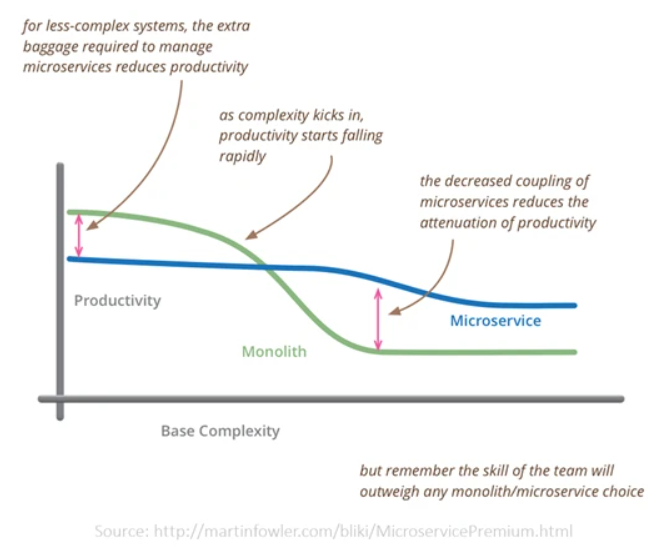
The Microservices Architecture is a variant of the Service-Oriented Architecture (SOA)—an evolved development approach that has emerged from the world of domain-driven design. Each microservice has a specific function. Yet together they form a complete application, or they perform a global task. Developers can deploy and test each microservice independently. Modern IT workflow consider Microservices as the first step to embrace a DevOps culture that—:
- Enables efficient computing
- Aids in building resilient applications
- Increased business process agility,
- Improved scalability and manage multiple things at a time
- Faster delivery and deployment to market
An “S” pattern adoption curve validates that there are numerous use cases in which companies benefit from using microservices to develop and deploy applications.
Originally, the technology begins as a great idea due to a need in some pockets, and the solution is developed to satisfy that need. People start considering it as an interesting technology for the future. Then, as its popularity spreads, the technology keeps upgrading on the coolness factor, and the recognition goes beyond the niche use-cases. You may get a clear idea of the concept from the below “coolness factor.”
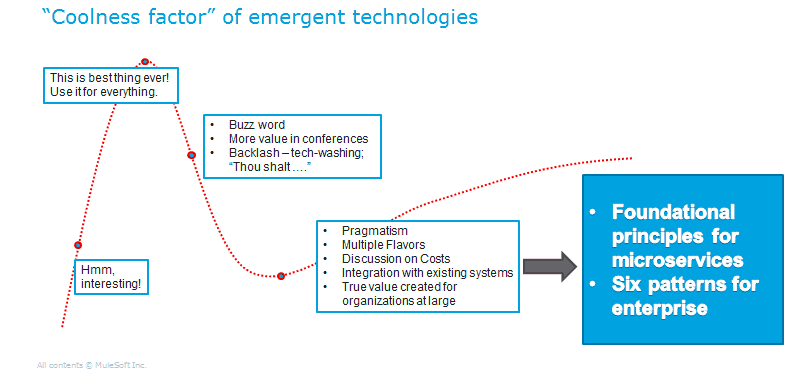
Conceptually, Microservices prolong the same principles that engineers have exercised for decades. Microservices implementation poses its challenges like most transformational trends. Organizations also notice increased complexity and effort to develop applications with a microservice framework by examining several use cases. In this article, we will discuss some challenges associated with building and deploying microservices including when you should not use microservices. Let’s have a look.
Challenges of Microservices
a. Design
Organizations face increased complexity when designing microservices compared to monolithic apps. Microservice Architecture is about splitting large, complex systems vertically (based on functional and business requirements) into smaller subsystems that are independently deployable. These sub-systems communicate with each other via a lightweight, language-agnostic network is known as either synchronous (e.g. REST, gRPC) or asynchronous way. If you are using Microservices first, you may face few difficulties such as:
- Confusions regarding each microservice’s size and a higher number of Moving parts (Services, Databases, Processes, Containers, Frameworks).
- Optimal boundaries and connection points between each microservice
- Designing the entire framework to integrate services is harder and time-consuming.
There are multiple design patterns in microservices architecture, but I will discuss Database per Microservice to make the idea crystal clear. If you are interested to know more about the other design patterns, check out Microservices architecture.
The database is the most important decision company faces once it replaces the large monolithic system with many smaller microservices. Many architects prefer having the database as it is, even when they migrate to microservice architecture. It is an anti-pattern, especially in a large-scale system, while it provides some short-term advantage, as the microservices will be tightly coupled in the database layer. A better approach is to provide every Microservice its Datastore, so that there is no strong coupling between services in the database layer. The bespoke design approach will also ensure that the Microservices are correctly segregated according to the Domain-Driven-Design.
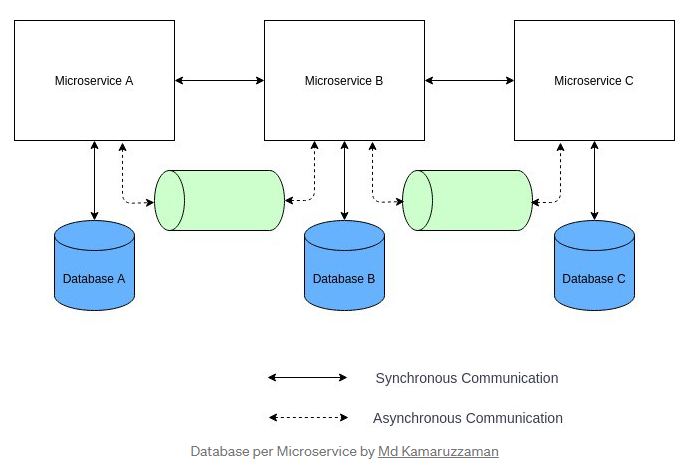
But here you may face difficulties Sharing data among services and Giving application-wide ACID transactional guarantee becomes a lot harder. Decomposing the Monolith database to smaller parts needs careful design which is another challenging task. Hence it is recommended to use this design approach while you are working in small-scale applications and one single team can develop all the Microservices.
A bounded context is required for designing microservices requires. Accordingly, every microservice should illuminate, encapsulate, and define a specific responsibility. To apply the same techniques for each responsibility/function, developers usually use a data-centric view when modeling a domain. This is the most challenging approach as, without logic, the data is pointless.
b. Security
Often Microservices are deployed across multi-cloud environments, that results in high-risk factor and loss of control on the visibility of application components—developers considering these additional vulnerable points. Unfortunately, security testing has not evolved quickly enough to address the risks introduced by this mass adoption of microservices. Vulnerabilities will appear in production if these concerns are not addressed in the SDLC. In addition to this challenge, each microservice communicates with others via various infrastructure layers, which makes testing even harder for these vulnerabilities.
Data security is another paramount concern within the microservices-based framework. Within such a framework data remains distributed. Confidentiality and integrity are correlated. Organization adapts this kind of tricky exercise to maintain the confidentiality, integrity, and privacy of user data.
The monolith application is manageable as you have one single thing to secure. Monolithic architectures are arranged in a single block (sic) and data is usually stored in one storage system. If we break down pillars, well, we can see that the monolith has to handle each pillar.
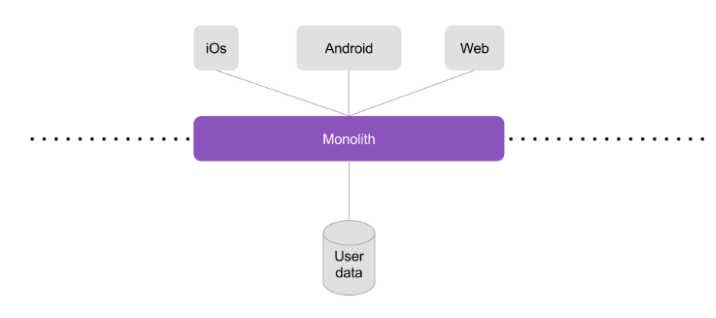

Now, if we are with a distributed architecture, Where we can consider 3 layers: clients (android, ios, web, …), API Gateways (or Backend for Frontend, BFF), and microservices and their data. There is responsibility segregation through the different layers. Mechanically, microservices are handling integrity, meanwhile exposed layers and front layers are taking care of confidentiality. Accessibility is also shared among all the panels as if they are not accessible, the platform is not functioning.


With microservices, the attack surface increases manifold. You need to take care of all the weaknesses they might expose for each one. Simple security-related bugs or plain old vulnerabilities in supporting libraries or their runtime environment can be the flaws in their design. As a result of this distributed framework, setting up access controls and administering secured authentication to individual services poses a technical challenge as well as increases the attack surface substantially.
c. Testing
The phase of testing is much more complex in microservices-based architecture than any software development lifecycle (SDLC). You must test individual services independently following the standalone nature of each microservice.
When we implemented multiple microservices in larger projects, the focus of the teams must have been on their microservices, resulting in a frequent lack of integration and testing approach. For instance, logging would be performed in a distinct format for complex microservices.
However, The different format was making it difficult to get all the essential information out of the log. Development teams also have to factor in integrating services and their interdependencies in test plans to manage these kinds of complexities.
d. Increased operational complexity:
Once a microservice is built, it needs to be deployed in several testing environments, and later in the production environment. As each microservice team is empowered to decide on its own, which technology to use, how to deploy the service, and where or how to run it, each microservice will most likely be deployed and operated in a different way.
- Traditional forms of monitoring are not sufficient for a microservices-based application. Suppose a request from the user interface traverses multiple services before getting to the one that can fulfill its request. The outcome of this traversal is a convoluted path of services, and without the proper monitoring instruments, recognizing the underlying cause of an issue is not only tricky—it’s often impossible.
- Scalability — an operational challenge associated with microservices architecture. Successfully scaling your microservice-based applications is challenging, although the scalability of microservices is often touted as an advantage. At the heart of these challenges lies something of a paradox.
To clarify the challenge, here I’m giving an example of two scenarios. When you are operating a single monolithic application from a single server, you can control an increase in demand by allotting more resources to the application. Or else, the individual user making use of an application, running new instances of it, and spread the load evenly in response to high demand.
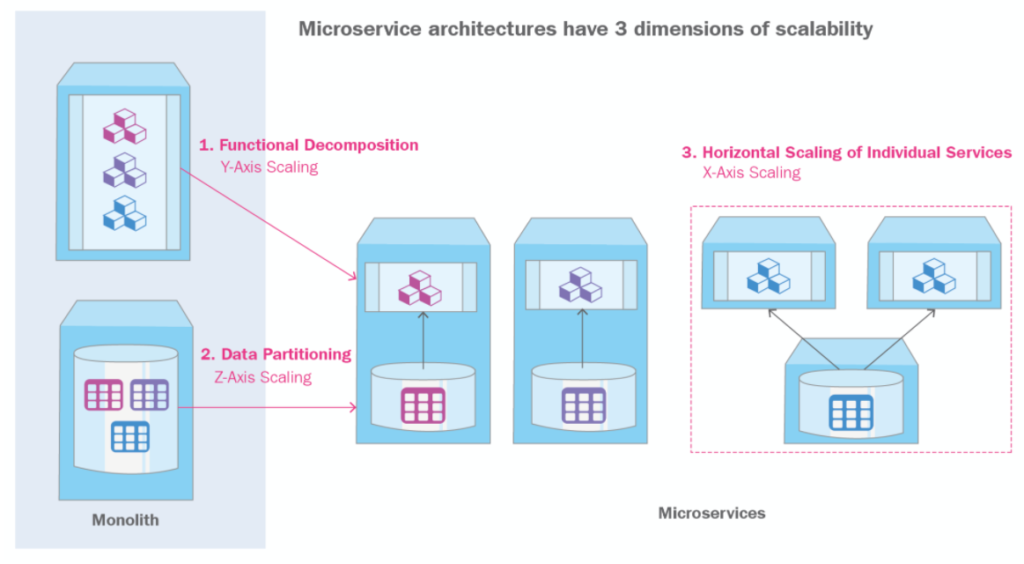
With microservices, on the other hand, upscaling can involve handling several different components and services. This indicates either all the elements need to upscale at the same time, or you need a means of identifying which individual components to upscale, as well as a method of assuring that they can still integrate with the rest of the system.
- Optimizing and scaling require more complex coordination. In a typical microservices framework, an application is broken down into smaller-independent services, hosted, and deployed across separate servers. Another challenge in this architecture is coordinating individual components, particularly when you experience a sudden spike in application usage.
- Fault tolerance is needed for every service. Enterprises demand their microservices to be resilient enough to confront internal and external failures. In a microservices-based application, one component failure can affect the entire system. Therefore, the framework you use must follow a design that considers error tolerance for each service that prevents the entire application from failing in the case of individual service downtime.
e. Complexity in communication:
Microservices that are deployed independently act as miniature standalone applications that communicate with each other. Hence, you have to configure infrastructure layers that enable resource sharing across services.
A poor configuration may lead to:
- Increased latency
- Reduced speed of calls across different services.
In this condition, you’ve received a non-optimized application with a slow response time. All the dependencies that used to be hidden in the monolith, coded in dependency rules between components, now have to be coded in the infrastructure configuration. However, Infrastructure communication is more tricky to maintain, no (not yet) development environment gives you red error indicators when IP addresses or ports mismatch between producer and consumer.
When to avoid Micro services:
Every enterprise moving to a new framework should perform thorough due diligence to ensure it’s the right fit.
These three situations will always help you explore microservices, decide when to skip the architecture for your chosen application.
When your defined domain is unclear or uncertain
Microservices have always been created within a bounded context. Now, think! Sometimes it ecomes logically tricky to break down your business requirements into specific domains as well as it will be equally difficult for you to create adequately sized microservices.
Another challenge of designing a proper means of communication among different services—this complexity is likely too much for you to realize maximum benefits in microservices. Here is the explanation of how an undefined or unclear domain causes difficulties for an organization.
Now, IT organizations embrace a system paradigm across all non-trivial business domains, event-oriented collaboration patterns have become a mainstay of such microsystem architecture design. These pitfalls tend to become a big bottleneck that thwarts event-oriented thinking on the journey toward evolutionary system design. To avoid these pitfalls, IT organizations must ensure that no microservice is designed without an explicit alignment and traceability with the business capability of the domain, as advocated by the bounded context strategy of domain-driven design.
Let’s explain a scenario. Sometimes, clients from the consumer lending domain desire to enable innovation and improve speed-to-market by transforming a single monolithic application into microservices with little or no focus on the design aspect of microservices. The circumstances can cause 500-plus microservices with extreme complexity leading to performance bottlenecks due to chatty inter-service communication.
Considering this kind of challenge, IT specialists always recommended a domain-driven rationalization to address this situation. This not only helps address performance challenges but also ensures the evolution of the application completely autonomously.
Hence, in the coming years, you need to be wiser about your domain design, and if you are not sure it’s wise not to use a micro services-oriented approach.
When improved efficiency isn’t guaranteed
No organization would not prefer to add up complexities and effort to adopt a culture without gaining improved efficiency. The idea of adopting Microservices is to embrace a DevOps culture that in turn:
- Employs automation: Microservices enhance agility, which fuels the ability to roll out new service versions. That agility is helpful for shorter build, test, and deploy cycles. Microservices can also
- Reduces cost and effort: A fault with a microservice only affects that microservice and its consumers. When monolithic applications experience an error, the entire monolith may break. Hence you may handle maximum work with minimum effort.
- Brings operational efficiency: it also incorporates the flexibility needed to employ service-specific security, replication, persistence, and monitoring configurations.
- Scalability: Organisations can scale up microservices independently by using pools, clusters, grids. That deployment feature makes microservices an excellent match for the elasticity of the cloud.
- Easy to manage: Microservices can leverage the agile methodology, where the application development effort is divided across teams that are smaller and work more independently.
Team strength is another major consideration for applying microservices architecture. For example, consider a relatively small development and operations team maintains the moderately large, moderately complex application. If it’s monolithic, the interactions between individual services may be very direct and may be optimized for specific tasks as required. A small development team is familiar with the code, and maintenance relatively simple for them.
If the same team needs to manage a microservice-based version of the same application, however, their overhead in terms of time and effort may increase significantly. Sometimes the architecture requires more coding time to implement even a minor change in data being handed from one service to another—and small design changes may require changes to the microservice orchestration and management system. It may create strain on the resources of the operations team, as well as the developers.
Hence, first, carry out your due diligence to verify if transitioning to a microservices framework helps achieve these goals.
When your application size is small or uncomplex
When your application size does not justify the need to split it into many smaller components, using a microservices framework may not be ideal. If your applications are already small enough, then there’s no need to break it further.
Remember that the idea of using a microservices framework is to break a complex application into a bunch of different, smaller services. When an application code is not complicated —already small enough and straightforward—transitioning it to a microservice framework will add complexities.
How could you measure Microservices as are the best choice for you?
If the benefits of using microservices outweigh the cons, then of course it is the best choice for you. But you should compare the business benefit with the effort and money you spent to set up the whole infrastructure and apply the approach.
While adopting a Microservice Architecture offers faster delivery and improved efficiency, businesses should deliberate carefully whether to opt for this approach. The benefits of transitioning from a monolithic to the microservices model are a dime a dozen—but there are still challenges to consider.
Here is one of our experiences! We have used Microservices architecture for a FinTech Application system because of its value regarding agility, scalability, and availability. The solution makes clients’ operation five times easy and gets a great response from the end-user level. Hence, for better guidance, you can always reach out to us.
Gartner VP analyst Stefan Van Der Zijden has mentioned “For many organizations, legacy systems are seen as holding back the business initiatives and business processes that rely on them,”
When we say legacy application, the first thought that comes to our mind any outdated technology that needs to be replaced or updated. One recent study reveals that more than one-third of all businesses continue using legacy apps that have not changed for over 15 years.
Legacy systems are not so reliable in keeping up with modern workflow and workloads. Sometimes, those applications also can’t handle the sheer volume and power required for new work processes, which makes them more likely to crash periodically. Companies have to spend enormous amounts of time and resources on keeping legacy apps functional or updating them to meet present needs. At some point, it is incredibly expensive to maintain and continue using these legacy apps.

Business facing problems from Legacy applications
The best approach to modernize legacy applications depends on the problems you are trying to solve. The added grunt of the Covid-19 pandemic has made it a necessary process to switch into a newer, more advanced environment to aid operations, IT, and their business in general. Modernization also paves the way for improving efficiency, optimized functions, and reducing costs. The sprawling digital adoption has made the situation more imperative for IT leaders to find effective ways to revive legacy systems. Knowing the risk-to-reward ratio before acting is now one of the main challenges for them.
Before delving into the ways of solution, let’s have a look at the four main factors that drive the need for modernization. If you check all the boxes below, then it is time for you to modernize your legacy applications—
- Are the market trends moving towards modernization?
- Is the demand for demographics shifting towards newer technologies?
- Do you have growing pressure on legacy systems to keep up with the changing needs of any project?
- Are you facing the inconvenience of use in work from home settings?
How to make the best approach for application modernization? — This is the thought that comes to your mind when you have already decided to renew your application. Here is the three-step evaluation provides direction in determining the best approach of application modernization depends on the problem that needs to be solved.
Phase 1: Six drivers for evaluating legacy system
Application modernization starts with the six main drivers. The legacy application is responsible for creating Complexities, concerns, or impediments results of its technology, architecture, or functionality.
Business prospection is one of the vital success factors for every business. Business prospection divides into three different categories called — business fit, business value, and agility. If, a legacy software/application can’t meet the new requirements imposed by digital business, then application modernized is the foremost option to fit properly and needs to be upgraded to provide greater business value. Business agility is one of the organizational methods, helps businesses adapt quickly to the first market changes. Sometimes, lack of application agility in keeping pace with the demands of digital business may be a cause of risk liability.
The remaining three drivers come from the IT perspective, which involves cost, complexity, and risk. Sometimes organizations face a lot of difficulties from the high cost of ownership. If you are dealing with complex technology infrastructure or security compliance – if your support or scalability are being compromised, then it is high time to modernize your legacy application.
Phase 2: Seven paths to evaluate modernization
Once the opportunity is selected and the problem identified, look at modernization options. The below options will help you choose the best-suited approach to ease the process and avoid business compliances. The below seven paths will guide your legacy app in modification.
1. Encapsulate: Leverage and extend the application features by encapsulating its data and functions. The process makes the application available as a service through an API.
2. Rehost: Without modifying the code, redeploy the application in different infrastructures, including physical, virtual, or cloud infrastructure.
3. Replatform: Organizations can migrate the application to a new runtime platform by making minimal changes to the code, but not the code structure, features, or functions.
4. Refactor: Restructure and optimize the existing code (although not its external behavior) to remove technical debt and improve nonfunctional attributes.
5. Rearchitect: Businesses can alter the code materially to shift the application to new application architecture and exploit new and better capabilities.
6. Rebuild: Redesign or rewrite the application component from scratch while preserving its scope and specifications.
7. Replace: Eliminate the former application component altogether and replace it. At the same time, consider the new business requirements and specifications.
Phase 3: Choose the best approach with the highest value and effect
Now you have multiple options for modernizing your legacy application but, you need to choose the best approach that will have the highest effect and value to your organization. An organization should map the bespoke seven options based on their influence on technology, architecture, functionality, cost, and risk.

Influence of factors (technology, architecture, functionality, cost, risk) on seven pillars
Basically, modernizing legacy software or applications means making the best decision between rearchitecting, rebuilding, or replacing. Rebuilding or replacing provides the best results with higher costs and risks, whereas rearchitecting has medium cost and risks. The key is to weigh all options to help identify the extent to which each will have the desired effect — with the minimum effort and maximum positive impact.
Now, it may be a question- how could an organization implement those processes to get rid of their legacy application. For those who don’t have the proper IT infrastructure or development support for modifying their existing system, consult with a Digital transformation Services company will be a well-rounded choice for them. An IT consulting company will support them with an A-To-Z application modernization roadmap.
Application modernization roadmap
A roadmap seems to be one common path that all the enterprises follow to successfully transition. But it is essential to remember that each organization has its journey, with personal goals and budgetary needs. The very first step is to break down monolithic applications into groups and small microservices. To rebuild from this point, cloud development service providers can guide you in the right direction with few general steps like

Roadmap for legacy application modernization
- Create a list of future goals before starting the actual process of transition. They help to conduct an application evaluation for making the transition smooth as well as gauge the probable difficulties while migrating to the targeted architecture. In this stage, your organization and targeted stakeholders should work together to reach a common achievable goal.
- After understanding the essence of each application, it is necessary to orient your business and goal settings in the same direction. Software consultants also identify the target audience, standardize the process and map the project from end to end in a much easier way.
- After assessment and prioritization, organizations need to look for the latest technology to aid modernization. In this situation, app development consultants will help you understand which technologies complement your applications and which ones don’t. They prioritize the features like scalability, agility, cost control, feature customization, and data security and allow you to have a hassle-free digital environment in the long run.
- In the final step, organizations implement the changes and make a transition. Review the infrastructure and collect feedback from the end-users can be the best course of action to run the application smoothly.
Some companies even try to explore ways of integrating with a digital workplace without making any changes to their existing application. I am hoping the above-mentioned strategies will help you to draw a positive solution in the future and apply the best approach by modernizing your legacy system with new technology.
With sprawling digital adoption fueled by emerging technologies such as cloud and AI, the enterprise IT landscape will be largely modernized over the next three to five years. Even as business leaders continue to look to CIOs to provide technology-driven differentiation in the marketplace, the enterprise applications ecosystem and its stakeholders will face new challenges. The demand for personalized micro-capabilities will soar, driving the need for continuous and rapid innovation – at scale.
As buyers increasingly play a direct role and assume an upper hand in the technology life cycle process, they will significantly impact how platform vendors, service providers, and developer communities evolve.
Those who foresee upcoming trends and adapt faster will outperform. This blog explores how enterprise applications are expected to evolve in the future and the impact it’s likely to produce beyond technology – for businesses as well as consumers.
Six trends shaping the future of enterprise applications
As technology disruptions upend our long-held knowledge on the value and ownership of enterprise applications, six major trends will define the future:
1. Hyper-contextual, micro-capabilities will lead to mass personalization at scale:
With cloud becoming the first choice for enterprise applications, the technology architecture of the future will be largely standardized across customers, allowing minimal customizations. Micro capabilities are basically Microservices or microservices architecture including cloud native architectural approach in which a single application is composed of many loosely coupled and independently deployable smaller components, or services. However, the key differentiating aspect of implementations will be highly personalized, contextualized micro-capabilities. These will not be a result of hard-coded customizations but will rather come from two different aspects:
A. Cloud enterprise platforms’ capability to configure hyper-personalizationrelevant to customer’s market context and composable architecture,
B. The evolving Apps marketplace publishing micro-capabilities through APIs. This means horizontal capabilities will be differentiated from micro-vertical capabilities and last-mile digital solutions.Security, data privacy, and regulatory concerns will ease significantly giving way to multi-cloud adoptions, except for some sector-specific applications that may remain on-premises with specialized capabilities built for a purpose.

Multi-cloud adoption
2. AI predictability will drive the selection of micro-capabilities:
Product assessment will be replaced with an outcome-drivenselection from a pool of capabilities, instead of standard modules-based subscription. Once business KPIs and expected outcomes are finalized, the enterprise platform’s AI engine will provide recommendations of relevant micro-capabilities to choose from libraries, based on customer’s market context, industry best practices, adoption of the capabilities across the customer base, and their historical success. AI predictabilitywill also be measured against outcomes.
3. Agile enterprise applications will reign:
Most application vendors will provide in-built agility in the life cycle of product capabilities developed. Upgrade frequency and features’ selection will be customized at source, even on multi-tenant architecture. Going forward, closed-loop systems will emerge to integrate user feedback directly into the product innovation cycle in near real-time, bringing the application implementation cycle closer to agile product development.

Agile Methodology in application
4. Businesses will be free from vendor lock-in:
Standardized technology architecture will eliminate vendor lock-ins, enabling organizations to switch vendors without risking a major change in application configuration implemented. It will be possible to have multiple products seamlessly delivering different micro-capabilities of a particular function or process for a customer. The adopted capabilities are expected to be highly portable across various enterprise platforms.
5. Buyer’s market will emerge:
With less fear of vendor lock-in and high portability, application vendors will offer new try and buy models without requiring any commitment for upfront investments. More mature vendors are also likely to offer outcome-linked subscription models, giving customers both assurance and flexibility to pay only when the desired outcomes are achieved. Business capabilities may also be priced based on outcomes.
6. The business experience will take center stage:
With digitalization becoming the norm in all business functions, the business experiencewill become sacrosanct. System of records will no longer be simply transactional; rather it will acquire strategic importance, as customers gain more direct access to back-office data and information. Likewise, the system of engagements will be under pressure to measure CX in terms of tangible outcomes. Such systems will, therefore, collaborate more with back-office functions and external ecosystems to adapt at the pace of business change. A zero-touch user interface will become a reality.

Analytics driven CX approach
The transformational impact on ecosystem partners
Let’s understand how the shift in enterprise application development impacts the key ecosystem partners:
1. Apps Marketplace will play an important role in developing micro-capabilities and shaping the enterprise landscape. Business capabilities will be published by various marketplace players, developers, and the crowdsourced community, leveraging individual experiences. Their API-driven approach for different products will further boost hyper-personalization and flexibility for customers. For instance, Salesforce is known for its leading AppExchange platform, where thousands of ISVs and developers have built enterprise products such as Vlocity for Industry Cloud & FinancialForce for PSA solutions. Many more will emerge going forward.
2. Cloud Platform services will be key to providing flexibility and scalability to customers. Integration platforms will become more API-based. Data, content & collaboration platforms will offer consumption-based pricing. AI & Analytics platforms will deliver enterprise business use cases that will be priced on outcomes. Blockchain and IoT platforms will have bundled pricing by consortia or based on customer impact. Low code, no code features will become de facto.

API based integration platform
3. Service Providers will play a challenging role as a core integrator of business capabilities – by processes, persona, and business needs. Some providers will also build capabilities in the Apps Marketplace which may remain IP owned by either the service provider or jointly with the client. With the democratization of application development, emerging citizen developers, and the growth in the crowdsourced community, the application development role of system integrators (SI) will be limited.
However, service providers can emerge as a critical success partner for their clients as SIs will be largely looked upon as Advisors and Integrators who can assume the role of the true custodian of customers’ enterprise IT assets by leveraging multi-disciplinary teams with domain knowledge, experience design, and change management capabilities – all of which will assume higher importance. They will work closely with customers not only to implement business capabilities but also to assess best-of-breed application capabilities for their specific needs.
With increased technical debt due to legacy and fragmented cloud applications, architecture know-how will become a key differentiator. In an open enterprise, SIs will play a major role as orchestrators and channelize the consortia of Apps marketplace vendors, platform partners, and external services for their clients.
4. End customers will truly become Prosumers, directly influencing decisions related to products and service offerings, thanks to micro-capabilities offering hyper-personalization. Most customers will have personalized AI tools or assistants, and AI will be considered a new stakeholder that needs to be managed or influenced.

Human-Robot’s interaction or Cobots
5. Business users prefer role and persona-based application experiences that need higher personalization and context-driven functionalities. Cobot is one of its examples, where robots are intended for direct human-robot interaction within a shared place or work in proximity to humans. Cobots will be embedded into the applications, helping users with the automation of business workflows and physical actions together. Going forward, some business users will also become mature citizen developers. Take, for instance, Instabase that provides a platform and automation tooling to build cloud business applications. Many such platforms will emerge as a powerful marketplace providing numerous micro-capabilities that empower citizen developers and power users in DIY mode.
6. CIOs will shift focus from administering the IT landscape to attaining business outcomes and measuring the ROI of capabilities. With less fear of vendor lock-in and agile capabilities available at scale, IT will continue to act as a key enabler of business and IT architecture will become highly composable. With these changes, some of the business spend will shift from buying or managing enterprise platforms to partnering with advisors and integrators to drive superior outcomes.
We have already stepped into a new application-driven year, where enterprise applications will play the role of an innovative catalyst to drive the engine for business.
After knowing the above facts and benefits, it can be a question that where a business should get the proper enterprise application solutions for aligning the new tech approach with business goals. For them, Inovar consulting can be a fruitful solution with correct application-driven strategy and skillful resource. Check out how we have applied application strategy in our different projects and reach us for more information.
Modern business means growing by the time and accommodate in a dynamic business world. Now Businesses do not have much time for training and coaching employees before starting any task as time is the most expensive resource, and every moment wasted in user training means a lot. That is where custom web application development turns into an ideal option among business owners. Furthermore, it will help to organize your business and keep all process unified that have an opportunity to work on what you need at the time.
Now the question is – why to opt for a custom web application development? As a business owner, you care to stand out from the crowd by building up a solid platform without compromising with product or service quality, then this is the way to go.
Decide the approach and explore available options
With the rapid advancement of technologies for both mobile and custom web apps, organizations fall into the dilemma of choosing the right medium to reach a targeted customer. The mobile application can run on a mobile device like a smartphone or tablet with the function of providing a service to its users. A web Application is a self-sustaining software run on the web browser that does not need to be downloaded and installed on the local machine of the end-user. But a custom web app would be the right choice for you if –
- Your webpage layout provides a better interface for your application
- Your targeted audience market prefers using browsers rather than a mobile
- You desire to apply dynamic updates to the entire application

(Source: www. caspio.com)
So, the main point is you need to determine the best suits approach for software application it may be related to the website or adopt a mobile-first technology or the combination of both approaches. After deciding on an approach, you need to explore the available option for a specific development.
Today, web application development platforms are using three types of development processes like no-code, low-code, and custom applications. Before selecting an option, let’s delve into what are these available options. No-Code: The visual development platforms do not need any coding skills for the application build. It allows using simple drag and drop of plugins to create functional applications, even the people who are not from a core technical background can we trained to use these platforms.
Low code: Low-code platforms support development more significant and modern way than no-code like the use of graphical interfaces with less programming than custom software development and offer minimal customization by coding as well if additional functionalities are required.
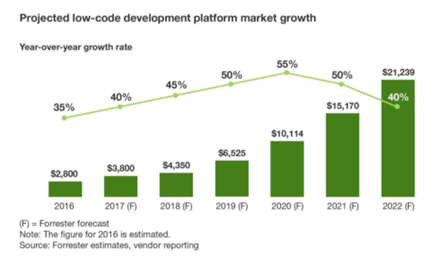
(Source: Forrester Report)
Custom development: Custom application development is the process of designing software applications for a specific user or a group of users within an organization. Developers design the custom application to address the specific needs within an organization that opposed to more traditional, standard software used by the masses.
Inovar develops custom applications that perfectly fit with your existing business software ecosystem and eliminates the need to use multiple applications for specific business functions. Depending on your business and technical requirements, we tailored a game-changing application solution for improving all your digital touchpoints.
Here we have mentioned all the possible options for you. Now it is your turn to dig deeper into how to pick the best approach that meets all business needs, and before moving forward, find out solutions align with your business goals.
Get a solution that fit your business goals
Once you choose the right approach next you have to choose the right app development methodology to apply modern software architecture, make software delivery faster, and meet your technical needs. There are multiple custom software development methodologies but select the right method is the most crucial part of every project. It is important that the project goals, definitions, and objectives are clearly stated at the nascent stage of the project. Companies can initiate the project once the complexities, client demand, and resources are sufficiently analysed.
Big bang methodology is mostly preferable for a simple and small project where clients are not aware of full requirements. The waterfall methodology is the most popular and oldest methodology of custom software development. On the other hand, RAD methodology focuses on the rapid development of your project. But A custom web development agency always prefers a process which fits their personnel and resources.
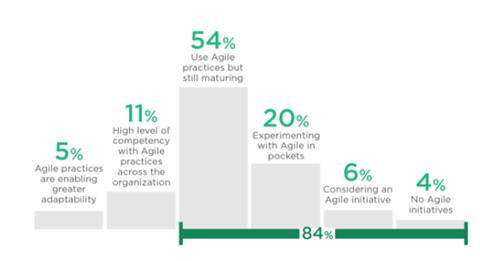
14th State of Agile methodology adoption
According to a statistical survey, 89% of the organizations have adopted agile methodology for its continuous delivery process, flexible features, and 83% of them conduct spring planning option as it involves incremental development, as well as developers can perform rapid iteration on a small chunk of the project. It also allows clients to get access to the project, review the work at each stage, implement changes constantly and share rapid feedback to the custom developer. In this way, we will help you to get an app with all facilities that will not be required to adjust too.
Benefits and support from full stack support developers
We all have seen how the COVID-19 virus spread like a forest fire and change business perception all over the world. After the new normal, the demand for remote work as well as the demand of Custom application on high. In case of custom web application development, you need full stack developers who will work as part of your teams and help to find solutions that you need.
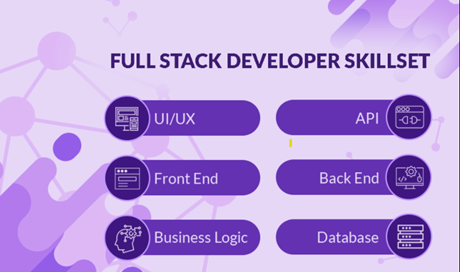
Support from full Stake Developers
Hiring a team of dedicated developers who can execute all the tasks related to the frontend and backend of the development becomes truly rewarding to build custom website applications. It prepares detailed customization on individual needs, makes the overall process highly structured, and leads the build of a steeler website. Inovar full stack developers orchestrate the capabilities to truly change the game, to take your business to the next level!
Choose the best suits based on your needs
From the above discussion, you are now well diverse with approaches and resources as well. Now it is your turn to choose the best suits for your business needs.
Adjust skill level with custom applications
According to the present situation, the most critical part is to pay attention to the user experience. The business decision-makers are aware of their workers and audience better than anyone else. Hence, they can create an interface that will complement their level of skills, engagement, and time. Custom app development is a lengthy process, and you can calculate its value in two different ways. If your employees use that app, then you could save a lot of time and deliver results within the deadline. On the other hand, if your customers ready to use that app, then you could analyse the positive and negative side of that app from their reviews.
Ensure Security with a unique set of protocols
Security is one of the tricky elements of custom web application development, and developers require a lot of attention while creating an independent system. If the application builds and runs seamlessly, then custom solutions can preserve business from hacking, cyber-attacks and ensure high security. The previous 5-year records are showing the effect of consistent improvement in high-risk vulnerabilities in web application development. According to Gartner, High-risk vulnerable code has dropped in web application 17% compared to the previous year. Still, companies need to apply a unique set of protocols from trusted sources and emphasize their constant updates.
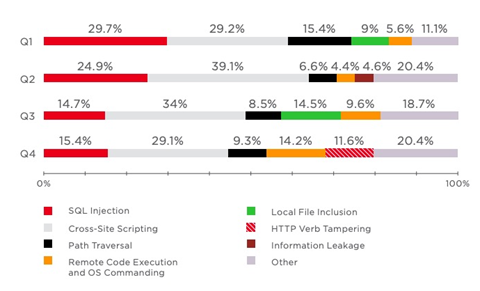
Top five Web application attacks by Quarter of 2018
Stay true to your brand and improve efficiency
Recognizable brand image is the most crucial part of a good business strategy that impacts positively on business success in the long run. By developing a custom app for customers, you can offer customized solutions that you need to dazzle them. The custom app also creates a visual representation of your brand image and send the message to your customers.
Save your money as well as time in the long run
Custom web apps cost a little bit more than other app-dev processes, but the significance is they will save your money in the long run. By applying this customized intuitive tool, you will be more friendly with your budget and save money for future investment. Low-code or no-code platform is less time consuming as a custom app dev involved several steps starting with wireframing and website prototyping, designing the user interface, and software development and testing. But Custom app helps to make an attractive solution in less time in the long run.
Custom web application development is not an overnight process. Just remember one thing, you should begin with a clear vision of what you want to achieve. You will need a team of full stack developers as well who will be there to help you define the vision and work side-by-side with you to make your vision a reality.
The best thing about a custom web app is that you can tackle a single specific process or create an all-encompassing system that your entire business will run on. Whichever way you decide to go, it will still be just what you need.
If you have already decided to choose a custom web application platform for your business upliftment, then feel free to contact us and register for a free demo. We are here to help you!